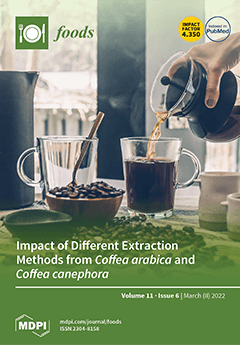Bacterial food poisoning cases due to
Salmonella have been linked with a variety of pork products. This study evaluated the effects of a
Salmonella-specific lytic bacteriophage and lactic acid (LA) on
Salmonella Enteritidis,
Salmonella Montevideo, and
Salmonella Heidelberg growth on raw pork
[...] Read more.
Bacterial food poisoning cases due to
Salmonella have been linked with a variety of pork products. This study evaluated the effects of a
Salmonella-specific lytic bacteriophage and lactic acid (LA) on
Salmonella Enteritidis,
Salmonella Montevideo, and
Salmonella Heidelberg growth on raw pork loins. Pork loins were cut into approximately 4 cm thick slices. Pork slices were randomly assigned to five treatment groups (control, DI water, LA 2.5%, phage 5%, and LA 2.5% + phage 5%) with six slices per group per replication. Pork loins were inoculated with 10
6 CFU/mL of
Salmonella spp. and stored at 4 °C for 30 min. After 1 h of treatment application and marination, phage 5% significantly (
p < 0.05) reduced the surface bacterial population by 2.30 logs when compared with the control group. Moreover, the combined treatment of LA 2.5% + phage 5% significantly (
p < 0.05) reduced the surface bacterial population by more than 2.36 logs after 1 h of marination. In the post-tenderization surface samples, the combination of both phage and LA showed a significant reduction (
p < 0.05) when compared with the control group. However, the treatments had no effect (
p > 0.05) when analyzing the translocation of pathogens on pork loins.
Full article






